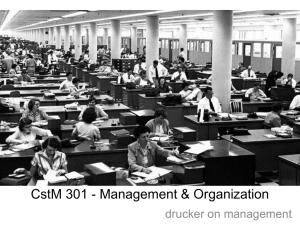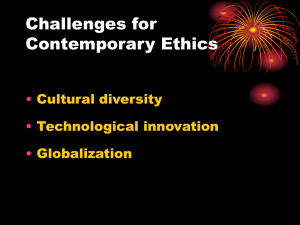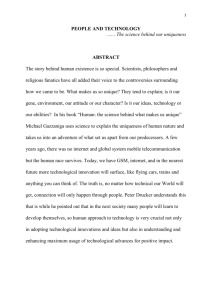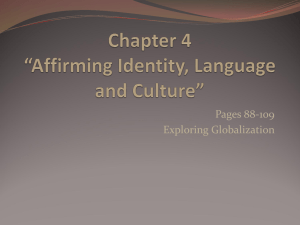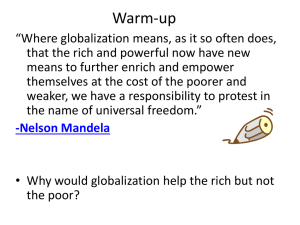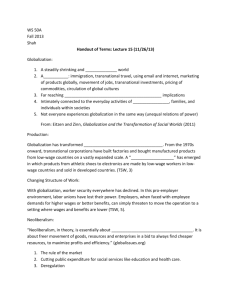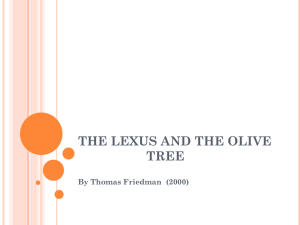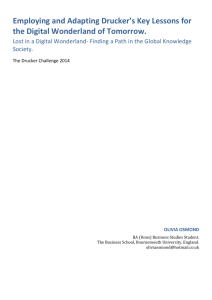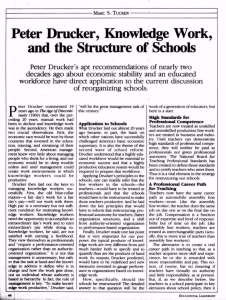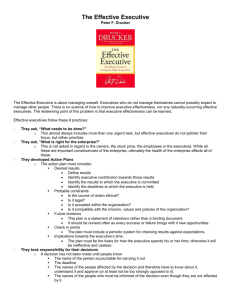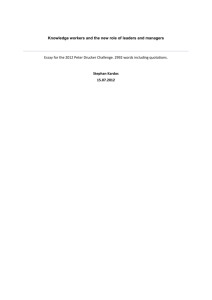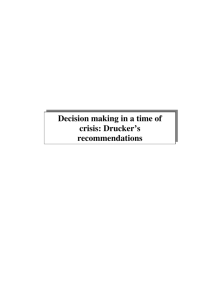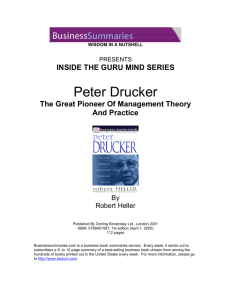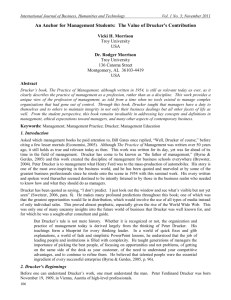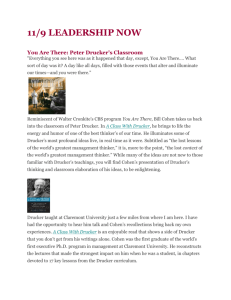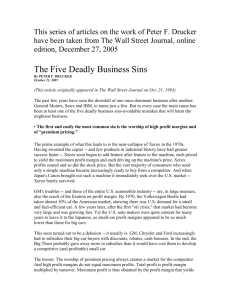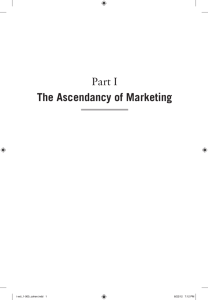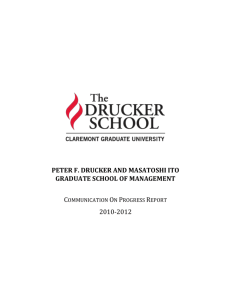Globalization today
advertisement
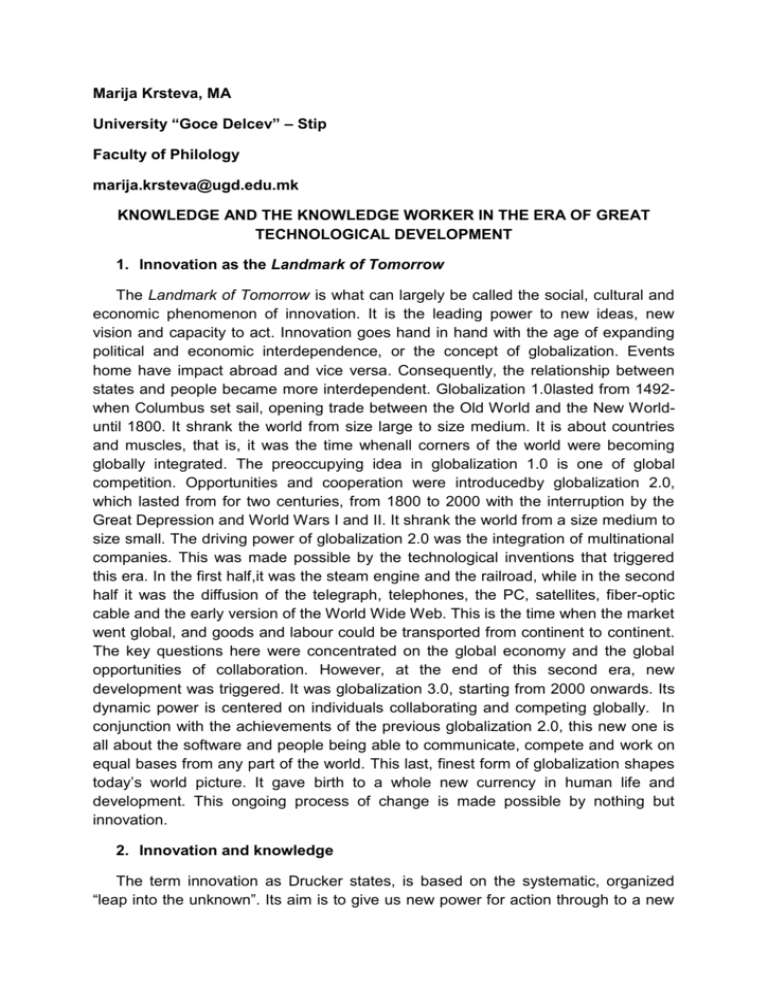
Marija Krsteva, MA University “Goce Delcev” – Stip Faculty of Philology marija.krsteva@ugd.edu.mk KNOWLEDGE AND THE KNOWLEDGE WORKER IN THE ERA OF GREAT TECHNOLOGICAL DEVELOPMENT 1. Innovation as the Landmark of Tomorrow The Landmark of Tomorrow is what can largely be called the social, cultural and economic phenomenon of innovation. It is the leading power to new ideas, new vision and capacity to act. Innovation goes hand in hand with the age of expanding political and economic interdependence, or the concept of globalization. Events home have impact abroad and vice versa. Consequently, the relationship between states and people became more interdependent. Globalization 1.0lasted from 1492when Columbus set sail, opening trade between the Old World and the New Worlduntil 1800. It shrank the world from size large to size medium. It is about countries and muscles, that is, it was the time whenall corners of the world were becoming globally integrated. The preoccupying idea in globalization 1.0 is one of global competition. Opportunities and cooperation were introducedby globalization 2.0, which lasted from for two centuries, from 1800 to 2000 with the interruption by the Great Depression and World Wars I and II. It shrank the world from a size medium to size small. The driving power of globalization 2.0 was the integration of multinational companies. This was made possible by the technological inventions that triggered this era. In the first half,it was the steam engine and the railroad, while in the second half it was the diffusion of the telegraph, telephones, the PC, satellites, fiber-optic cable and the early version of the World Wide Web. This is the time when the market went global, and goods and labour could be transported from continent to continent. The key questions here were concentrated on the global economy and the global opportunities of collaboration. However, at the end of this second era, new development was triggered. It was globalization 3.0, starting from 2000 onwards. Its dynamic power is centered on individuals collaborating and competing globally. In conjunction with the achievements of the previous globalization 2.0, this new one is all about the software and people being able to communicate, compete and work on equal bases from any part of the world. This last, finest form of globalization shapes today’s world picture. It gave birth to a whole new currency in human life and development. This ongoing process of change is made possible by nothing but innovation. 2. Innovation and knowledge The term innovation as Drucker states, is based on the systematic, organized “leap into the unknown”. Its aim is to give us new power for action through to a new capacity to see, a new vision. Its tools are scientific; but its process if of the imagination, its method the organization of ignorance rather than that of known facts. The impact of this new power on our lives is already great. It changes our technology and gives us new opportunities to make technological advance to order (Drucker 1957). Peter Drucker’s particular insight on people’s place and individual role in the changing world draws pattern between knowledge and innovation in the 21st century. As the complete picture of human society changes, so does the work of its institutions. The government, the schools, the armed forces alongside with the business enterprises and research organizations have all taken up central place in the dissemination of innovation and knowledge. It is a combination of scientific facts and the work of the individual imagination and it always produces a new and upgraded version. Nevertheless, innovation represents more than a new method. It is a new view of universe, as one of risk rather than of chance or certainty. It is a new view of man’s role in the universe; he creates order by taking risks. And this means that innovation rather than being an assertion of human power is an acceptance of new responsibility (Drucker 1957). The organized form of people being able to accomplish the roles of taking both risks and responsibility is that of research. It breaks new grounds and pushes the limits of both scientific discovery and power of imagination. Even though it does not change the permanent limitation of human existence it adds new dimensions. Social, economic and cultural development is becoming largely dependent on conducting research and producing knowledge. Similarly, the most common current definition of innovation would be that it is a purposeful change by means of systematic inquiry we call scientific method and of the new knowledge gained thereby (Drucker 1957). In this respect, scientific knowledge has become the tool for effective change. This relationship creates the system of organization between knowledge and its application. But how is such system to function in the new globalized world of digital technology? 3. The knowledge worker in the world of digital technology and innovation The main target of this process is the individual, or the knowledge worker. People across the globe would have to learn how to make their way through the sea of knowledge powered by the cutting-edge technologies. This inevitably implicates the complete work and function of the organizations. A strategy to deal with the innovation and knowledge dissemination is essential in the process of organization and management. In order for people to work both locally and globally, a personal and corporative management is necessary. It should be directed to active participation in the global technological innovations and processes. Knowledge and work on the global scene are becoming inextricably bound and the technological process is here to prove that. Scientific and social development become interdependent on a global level. This creates one of the biggest challenges of the 21st century as Drucker states, the productivity of the knowledge workers and their management. In order to raise their productivity, knowledge has to be improved, challenged, and increased constantly, or it vanishes. Getting the knowledge worker to engage in their personal management and the management of the whole group by following a strategy for their development will enable them to respond more successfully in their daily routine. 4. The knowledge worker and the business management The task of the entrepreneur isalways to search for change, respond to it, and exploit it as an opportunity. When it comes to problem-solving or a case management the knowledge worker’s response is the main instrument in the process of adapting to different circumstances. The main aspects to be considered involve goal-driven, knowledge intensive and highly collaborative working environment. The knowledge workers of the 21st century have the power no potential entrepreneur had before. It is today’s knowledge that gives them the power and control to access and advancement. The knowledge worker has the access to information services 24 hours a day on a world wide web. This opportunity defines their map of work, internal and external sources, and communities of practice, web search and ultimate personal and corporate research. The system enables them to make immediate analyses and see the potential results. At the same time, the digital world provides constant interaction. It is an open source of communication that enables the workers to directly engage in the process of innovation, by providing solutions that have not been made or invented before. It is a process of both working and learning at the same time. In the business department, this process of making knowledge sustainable asset means that a strategy for a proper distribution of expertise and mentoring should be made. In addition, emphasis should be given to the sector and role division so that different tasks would be performed successfully and on time. Inevitably technology is turning the knowledge worker into a skilled talent. The creation of a confident knowledge worker will create secure and stable business relations despite the uncertainties luring from the digital technologies. As Drucker said, the installment of computers to reduce the employment of clerks leads to more and more expensive clerks even though they call them 'operators' or 'programmers.'Additional challenge in the whole process is the constant demand for new trained people in all areas of management. A strong managerial knowledge base is necessary for the developing countires. In my opinion, it is the purpose of business and entrepreneurship that will keep the innovation process running. As the global communication increases with the digital facilities so will the need of expert knowledge workers. While some boundaries will be overcome, other strongholds will be reinforced. Constant knowledge upgrade will lead to clearer objectives for the management and vice versa. The cut in the time and space costs will only add to that. In this way, the negative sides of the digital technologies can be tamed and neutralized. Bibliography: 1. Drucker, Peter. Ferdinand. Classic Drucker (2006) Harvard Business School 2. 3. 4. 5. 6. Publishing Corporation, Massachusetts Drucker, Peter. Ferdinand. Landmarks of Tomorrow (1957) Transaction Publishers, Rutgers. New Jersey Friedman, Thomas L., The World is Flat, A Brief History of the twenty-first century, (2005) Farrar, Straus and Gieroux, New York How Knowledge Workers Get Things Done Ed. By Layna Fischer. (2012) Future Strategies Inc. Lighthouse Point FL, USA Living with America, Ed. Giorcelli, Chrisitna; Kroes, Rob (p.5). (1997) VU University Press, Amsterdam The Global Transformations Reader, An Introduction to the Globalization Debate, Ed. Held, David., McGrew, Antony. (2003), Polity Press in association with Blackwell Publishing Ltd., Cambridge
